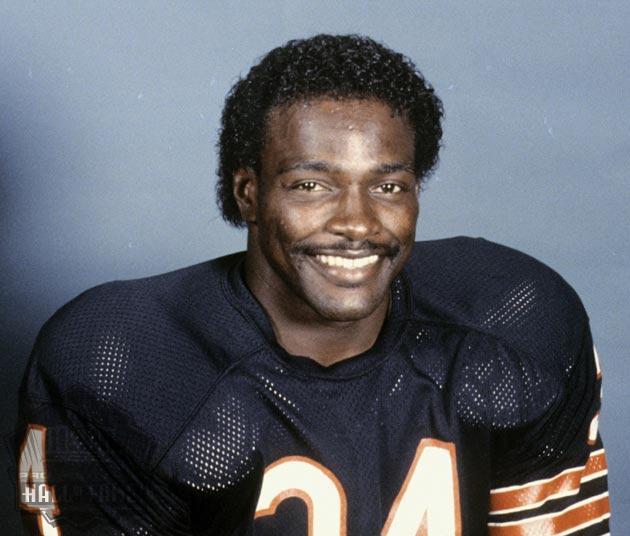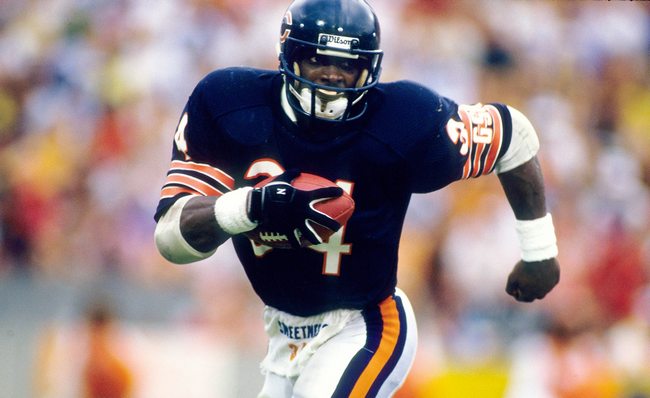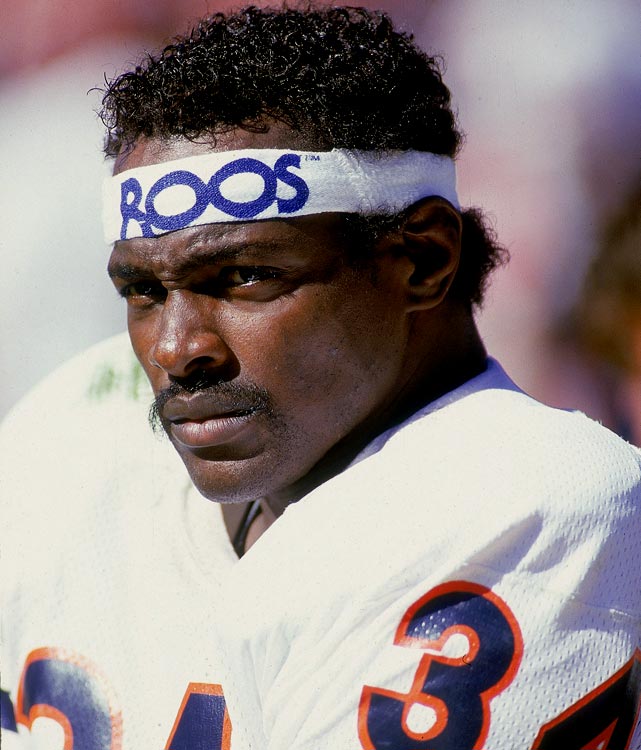Walter Payton (Walter Payton)

Payton was one of three children born to Peter and Alyne Payton in Columbia, Mississippi. His father was a factory worker who had played semi-professional baseball. Payton was an active member of the Boy Scouts, Little League, and his local church. At John J. Jefferson High School, Payton played drums in the marching band, participated in the track team and sang in the school choir. Outside of school, he played drums in jazz-rock groups.
His brother Eddie was on the football team, and Payton did not play partly to avoid competing with him. After Eddie graduated, the football coach asked Payton to try out for the team, and he agreed on condition that he be allowed to continue playing in the band.
Once he began to play football, as a junior, he achieved instant success as a running back. At 5 ft 10 in (1.78 m), he was not especially large, but his speed and strength made him one of the team’s featured players. Jefferson High School was integrated with neighboring Columbia High School that year; Payton and his teammates were upset that their head coach, Charles L. Boston, had become an assistant and Payton boycotted some of the spring practices in protest, but returned during the fall season. He then earned state-wide honors as a member of Mississippi’s all-state team, leading Columbia to an unexpected 8-2 season. His performance helped ease the local tensions surrounding desegregation.
Though Payton had established himself as one of Mississippi’s best running back prospects, he received no invitations from Southeastern Conference colleges or universities, which were accepting only a few black players at the time. After originally committing to Kansas State University, he decided to pursue his collegiate career at the historically black, Jackson State University, where his older brother Eddie played football (he also declined a scholarship offer from the University of Kansas, where fellow Chicago Bears running back legend Gale Sayers had played).
While attending Jackson State, Payton played alongside many future professional football players, including Jerome Barkum, Robert Brazile, and Jackie Slater. As a member of the Jackson State Tigers, Payton rushed for more than 3,500 yards, averaging 6.1 yards per carry. Also, he broke the NCAA’s scoring record by rushing for 65 touchdowns during his college career. In 1973, Payton was selected for the All-American Team. The following year he was named Black College Player of the Year. Payton graduated in 1975 with a Bachelor’s degree in Communications.
He acquired the nickname “Sweetness” in college. The nickname’s origin is ambiguous: it is variously said to have stemmed from his personality, from his athletic grace, or as a sarcastic description of his aggressive playing style. In 1996, Payton was inducted into the College Football Hall of Fame. On January 18, 2010, it was announced that Payton would be one of eleven members of the inaugural class inducted into the Black College Football Hall of Fame on February 20, 2010.
On October 1, 1972 during Walter Payton’s sophomore year, he set a then-best SWAC scoring record by scoring 7 touchdowns and running two points after for 46 points as Jackson State crushed Lane College, 72-0. Payton scored on TD runs of 6, 8, 2, 3, 1, 2, and 31 yards in the blowout win.
The Chicago Bears drafted Walter Payton in the first round of the 1975 NFL Draft, as the fourth overall pick. The Bears had endured several losing seasons after the retirement of the iconic Gale Sayers in 1972. Payton’s first game was not particularly successful; he was held to zero net rushing yards on eight attempts. His best performance of the season was the final game against the New Orleans Saints, where he rushed for 134 yards on 20 carries. Payton finished the season with only 679 yards and seven touchdowns. However, Payton led the league in yards per kickoff returns.
Payton was eager to improve his performance. During the 1976 NFL season, Payton rushed for more than 1,000 yards and scored 17 touchdowns. After the season, he was selected to play in the 1977 Pro Bowl, where he was declared the Pro Bowl MVP. The next year, he rushed for 1,852 yards and scored 16 touchdowns, becoming the league’s leading scorer for the season. He earned numerous awards that season, including the Associated Press and Pro Football Writers of America’s Most Valuable Player awards. A memorable game of the 1977 NFL season was against the Minnesota Vikings on November 20. He rushed for a then-record 275 yards, breaking the previous record of 273 yards held by O. J. Simpson. In that record-setting game against the Vikings, Payton was suffering with a 101-degree fever and intense flu. His longest run was for 58 yards, and he caught one pass for 6 yards. His record stood for 23 years until Corey Dillon of the Cincinnati Bengals ran for 278 yards in 2000. By the end of the decade, Payton had received additional accolades for his exploits as a blocker, receiver, emergency punter, and quarterback.
The Bears struggled to assemble consecutive winning seasons, landing only two playoff berths since his arrival. The lack of success prompted the Bears’ management to replace Neill Armstrong with Mike Ditka for the season that began in the Fall of 1982. Ditka, a tight end during the 1960s and 1970s who would also join the Pro Football Hall of Fame, led the Bears to a 3–6 (strike-shortened) record in 1982. He led the Bears to an 8–8 finish in 1983 and to a 10–6 finish in 1984. Payton continued his success by rushing for more than 1,400 yards in both seasons. On October 7, 1984 against the New Orleans Saints, Payton broke Jim Brown’s career rushing record of 12,312 yards. In 1985, Payton rushed for more than 1,500 yards, helping the Bears establish the league’s second-best offense. The Bears’ 46 defense of that season would go on to become one of the best in NFL history, setting a record for fewest points allowed.
Payton performed with his teammates in the widely released 1985 music video The Super Bowl Shuffle. The Bears went on to a 15–1 record that culminated in a 46-10 victory over the New England Patriots in Super Bowl XX. Although Payton’s offensive prowess had assisted the Bears throughout the 1985 season, the New England Patriots prevented him from reaching the end zone. According to quarterback Jim McMahon, he was targeted by two or three defenders on every play. In a later interview, Ditka stated that Payton’s lack of a touchdown in this game was one of his major regrets.
Payton, who was a 12-year veteran, amassed 1,333 yards in the 1986 NFL season. The Bears won the NFC Central Division, but lost to the Washington Redskins 27–13 in the divisional round. At the end of the 1986 season, he announced that he would retire after completing the 1987 NFL season. During his last season with the Bears, Payton split carries with his successor, Neal Anderson, and rushed for only 533 yards. Payton’s career ended with another loss to the Washington Redskins in the divisional round of the playoffs by the score of 21–17 on January 10, 1988. Over his entire career, Payton rushed for 16,726 yards, which broke the record for most rushing yards by any NFL player in history, and scored 110 touchdowns. He caught 492 passes for 4,538 yards and 15 touchdowns. Payton set several team records, including most career rushing yards, receptions, touchdowns, and touchdown passes by a running back. His jersey number was retired by the Bears, and he was inducted into the Pro Football Hall of Fame in 1993. The only game he missed in his 13-year career was in his rookie season of 1975.
Payton’s motto was “Never Die Easy”, which is also the title of his posthumously published autobiography. Payton attributed this motto to Bob Hill, his coach at Jackson State. In practice, this meant that Payton refused to deliberately run out-of-bounds and always delivered some punishment to his tacklers before being forced off the field or forced down.
One of Payton’s signature maneuvers was the “stutter-step”, a high-stepping, irregularly paced run. He developed this as a way to distract his pursuers during long runs, saying that it startled them into thinking and gave him some advantage over players who were actually faster runners. In his autobiography, he likened the stutter step to a kind of “option play”: when he was stutter-stepping, defenders would have to commit to a pursuit angle based upon whether they thought he would accelerate after the stutter-step, or cut — he would read this angle and do the opposite of what the defender had committed to.
He re-invented the practice of stiff-arming his tacklers, which had gone out of favor among running backs in the 1970s. At times, he used his high school experience as a long jumper to leap over his opponents, landing on his head in the end zone to gain a touchdown in a game against the Buffalo Bills. His running gait was somewhat unusual, as his knees were minimally bent, and the motion was largely powered from the hip. This may have given his knees, a football player’s most vulnerable joints, some protection, although he underwent arthroscopic surgery on both knees in 1983. He referred to this procedure as an 11,000-yard checkup.
After scoring touchdowns, Payton declined to celebrate; instead, he would often hand the ball to his teammates or the official. He disapproved of the growing practice of touchdown celebrations; he preferred post-game antics such as rushing into the locker room and locking his teammates out in the cold while taking a long shower. Although Payton would have won the respect of his peers and coaches by his running alone, he made 492 receptions and over 4,000 yards over his career and was a consistent threat in the passing game.
Payton married Connie Norwood in 1976. During his rookie year he resided in a home on the north side of Arlington Heights, Illinois. The couple had two children, Jarrett Payton (born 1980) and Brittney (born December 26, 1985) and resided in South Barrington, Illinois.
In 1995, Payton, along with many other investors, sought to bring an NFL expansion team to St. Louis, Missouri, and Payton expressed his interest in becoming the first minority owner in NFL history. Although the NFL strongly favored a franchise in St. Louis, their efforts were thwarted because of internal dissension among the investment group members leading the NFL to award franchises to investment groups in Jacksonville, Florida (Jacksonville Jaguars) and Charlotte, North Carolina (Carolina Panthers). St. Louis eventually received a team when the Los Angeles Rams moved to the city in 1995.
Payton pursued various business ventures in retirement, including becoming co-owner of Dale Coyne Racing in the CART IndyCar World Series. He also drove in several Trans-Am Series events, including a 1993 race at Road America in which his car overturned and caught fire. He suffered burns but escaped serious injury.
In 1995, he and several partners purchased a Chicago, Burlington and Quincy Railroad roundhouse in Aurora, Illinois. The property became known as “Walter Payton’s Roundhouse”, hosting a restaurant, brewery, banquet and meeting facility, and museum. In 1999 the property received an award from the National Trust for Historic Preservation. The beers brewed at the Roundhouse received awards in the 2000s. Payton appeared on a 1987 episode of Saturday Night Live (co-hosting with fellow football player Joe Montana). In 1994, he made an appearance at Summerslam in the corner of Razor Ramon.
In February 1999, Payton announced that he had a rare autoimmune liver disease known as primary sclerosing cholangitis, which may have led to his cholangiocarcinoma (bile duct cancer). He spent his final months as an advocate for organ transplants, appearing in many commercials to encourage others to donate organs, although by the time his first appeal was recorded, his illness was already too far advanced for transplantation to have been a viable option. In April of that year, Payton made a final public appearance at a Chicago Cubs game with Mike Ditka, where he threw the game’s ceremonial first pitch. Author Don Yaeger worked with him during the last weeks of his life to create his autobiography, Never Die Easy.
On November 1, 1999, Payton died from the complications that arose from his illness. He was 45 years old. During the same week, the NFL held special ceremonies in each game to commemorate his career and legacy. In addition, the Chicago Bears wore special #34 patches on their jerseys to honor Payton. His body was cremated after his death.
Speakers at Payton’s public funeral service, held in Soldier Field, included Jesse Jackson; then National Football League Commissioner Paul Tagliabue; former teammate Dan Hampton; his widow Connie Payton; and his children, Jarrett and Brittney. Among the 1,000 mourners at the private service were John Madden; Illinois Governor George Ryan; Chicago’s mayor Richard M. Daley; former teammates Matt Suhey, Mike Singletary, Roland Harper, and Jim McMahon; the Bears’ equipment manager and building superintendent; and many other people representing a wide social, political, and economic spectrum.
Born
- July, 25, 1954
- USA
- Columbia, Mississippi
Died
- November, 01, 1999
- USA
- South Barrington, Illinois
Cemetery
Other
- Cremated




